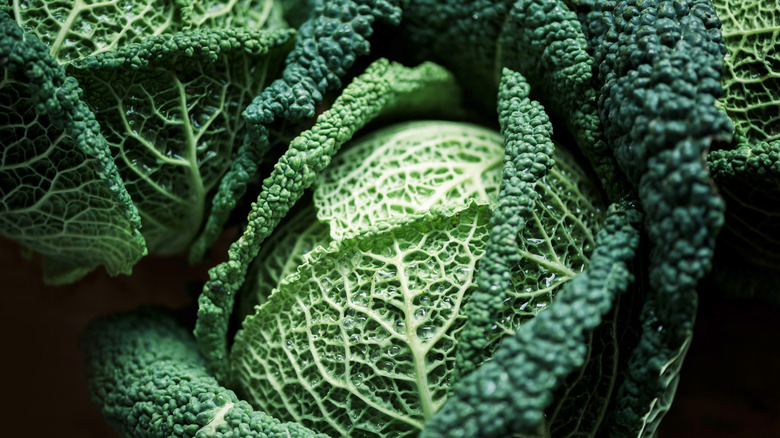Why The Inner And Outer Leaves Of Savoy Cabbage Are Used Differently
If you had to name your favorite vegetable, what would you answer? We're willing to bet a lot of folks might chime in with avocado, that magical, creamy guacamole ingredient that's actually a fruit. Or perhaps the humble potato, which shines so brilliantly in everything from fries to gratin. There might even be some responses of carrots, broccoli, or the once-trendy all-star kale. However, it seems less likely that a majority of folks would choose cabbage, that hearty cold-weather staple, as their top veggie.
Exceedingly common in chilly climates such as Russia and Poland (via We Grow for the World), the cruciferous vegetable is typically harvested in the fall and can be stored all winter long for incorporation into nutritious soups, stews, and salads (via Almanac). It's no wonder that in the era prior to refrigeration, cabbages were such a common feature in root cellars or even buried underground in cold soil, where the vegetables will last for up to four months (via Harvest to Table).
While cabbage might not be winning any popularity contests in America or other countries where it's a less common feature of the cuisine, cabbage is certainly delicious, bringing crunch and brightness in the form of coleslaw and softness and sweetness in the form of braised cabbage. And one of the many great things about this veg is its sheer variety.
Savoy cabbage is like two cabbages in one
If you're only familiar with the big, round, heavy heads of red and green cabbage, there's a whole world of this vegetable waiting for you to discover. According to BloomIQ, cabbage is grown in more than 400 varieties around the globe, in shapes from round to conical and textures ranging from soft and lacy to crisp and dense. And if you really like cabbage in all its characteristics, then Savoy cabbage might be a great type for you to look for at the store.
The Spruce Eats notes that this green, wrinkly-looking cabbage is like two vegetables in one, its larger outer leaves soft and pliable, making them a perfect vehicle for stuffed cabbage rolls and raw wraps, while the inner leaves are much more firm and crisp. These inner leaves are a great addition to a salad or slaw, or for tossing into a stir fry where some crunch and texture are needed. The outlet writes that you can also use both types of leaves in one dish, providing a nice textural contrast. So the next time you want two types of cabbages for the price of one, reach for Savoy and have some fun in the kitchen.

